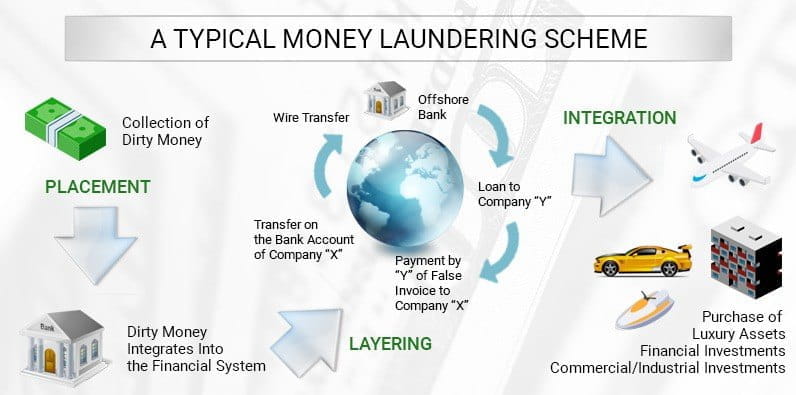Casino Money Laundering Stages
Money laundering is a term used to describe the process of taking funds generated from illegal activities and making legitimate and clean. In this article, we are going to explore three general stages of money laundering and ways to combat money laundering crimes.
Money laundering typically includes three stages: placement, layering and integration stage.
- Money laundering typically occurs in three stages: placement, layering and integration. In Canada, money laundering is a criminal offence that covers all three stages of money laundering activity. The structure of gambling in Canada differs in important ways from.
- You go into Macau with a suitcase full of money, buy a ton of casino chips, and then you wander around. You then cash in the chips and claim that you just got really, really lucky at bacarrat.
Typically, a money launderer commences laundering his “dirty” money at the “cash-in” stage (“dirty” money in exchange for casino chips) and completes the laundering process in the casino at the “cash-out” stage (ie, “dirty” money in exchange for a casino cheque). This is the “placement” 2 stage of money laundering. Chapter 3: Description of Possible Money Laundering Schemes A.1) Methods of Money Laundering through the Use of Casino Value Instruments 6. Casinos utilize various value carriers or instruments to facilitate the gambling process, and the type and use of these instruments differ depending on both local.


Placement Stage
Placement is the first step of money laundering which is the process of moving the money into the legitimate source via financial institutions, casinos, financial instruments etc. and at the same time, hiding its source. There are many ways of money laundering which are explained in the articles linked at the end of this post. This is the most vulnerable stage of money laundering as criminals are holding on to a bulk of funds and placing it into the financial system, which may attract the attention of law enforcement agencies.
Layering Stage
The second stage is “layering”, sometimes it’s also referred to as “structuring stage”. It breaks the funds into small transactions and makes it difficult to detect and find out about the laundering activity. It usually entails international money movement, so the law enforcement agencies won’t be able to track the financial gains from illegal proceedings so easily.
In this stage, money will be moving around the globe electronically, trading in overseas markets. Criminals usually convert the cash into monetary instruments once the funds are placed in the financial system without detection. The proceeds can either be banker’s drafts or money orders. In the modern world, the funds can also be used for trading in different stocks or currencies across different markets.
Another common way that criminals use to cover the trail is buying assets with the cash and selling them. Assets can be re-sold locally or abroad and hence makes it harder to trace and thus seize.
Integration Stage
Integration stage is the final stage of money laundering, in which the money is now returned to the criminals legitimately after it has been placed in the financial system, often breaking it into different multiple smaller financial transactions. Criminals can now retrieve their illicit funds in a legal way after fully integrating them into a legitimate source, and are able to use them for any purpose. Most of the redemptions are usually through buying luxurious assets like properties, jewellery etc. – items that require a large amount of money and will not draw as much attention.
How to combat money laundering?
According to an article published in Thomson Reuters, five ways are suggested to combat money laundering activities. They are:
- Improve searches with technology
With the advancement of technology, such as Artificial Intelligence (AI), detect false positives and conduct searches 24/7 to lessen the burden of the anti-money laundering (AML) regulators to weed out false positives and expand searches. - Regular-cross communication
Constant communication among different parties, including law enforcement agencies, governments and regulators etc. Communication can keep all parties up-to-date, verify any suspicions, identify possible networks, and enhance the public-private partnership, ultimately creating a united front against money launderers. - Leverage data analytics to detect patterns
As there is more data available nowadays, regulators can identify and detect patterns through past data information and develop a client model to trace any suspicions. - System standardization
With the different anti-fraud measures in different regulatory institutions, some issues may arise from different jurisdictions using a network of legacy computer systems. Without standardization, it makes it harder to communicate and process data in a collective way with other parties and hence can hinder fraud detection. - Training
Having the right personnel is very important when it comes to detecting fraud. Training is essential and companies may consider people to train employees, make stakeholders aware of any suspicious activity and take relevant action when there is any hint of fraud. It’s also important to have someone in charge to stay on top of news and technological developments, and to oversee the fraud detection process.
Money laundering is getting harder to detect and trace due to the changing technology and integration of economies among markets. It is important for us to understand the origin of the source of funds by having a swift, reliable identification verification system to stop offenders in the beginning stages of money laundering. With a reliable digital ID system, it is easier to track bad actors who are trying to conduct illegal money laundering activities.
Blockpass provides a solution which is ideal for customer due diligence. With fast and secure KYC and AML compliance, and the ability to flexibly, quickly and easily manage identities, it ensures regulatory compliance without the hassle traditionally associated with KYC. The Blockpass model would also be ideal for a number of industries, including online businesses, financial institutions and the cryptocurrency industry, which can all see a large number of users who need identity. Aiming for the highest standards in regulatory compliance, Blockpass’ reusable KYC solution can help combat money laundering without causing a lot of financial burdens to companies.
Information:
Casinos have historically been at risk of exploitation by those seeking to launder criminal property. We look at five things you need to know about the problem, rules and changes to sector guidance.
1. Why is this important?
The nature of services and products offered by the gambling industry can make it attractive to criminals seeking to launder or disguise the origins of criminally derived funds. Significant risk factors in this industry include the prevalence of cash transactions, accessibility to multiple premises and anonymity on the part of the customer.

2. Who is covered by the rules?
New anti-money laundering provisions relating to casinos were brought in by the Money Laundering Regulations 2017 (MLR 2017) on 26 June 2017. A key change is that all casino operators, both remote and non-remote, are now caught by MLR 2017, rather than simply holders of a casino operating licence. A remote casino operator will be caught by the MLR 2017 if they have at least one piece of remote gambling equipment situated in the UK or if the gambling facilities provided by the remote casino are used in the UK.
This means that non-casino gambling providers, such as betting shops, are not covered by the MLR 2017.
3. What are the rules?
Under the MLR 2017, casino operators have a legal obligation to do the following:
- Risk assessment: conduct a written risk assessment in respect of money laundering risks faced by the business and ensure that there are adequate procedures in place to deal with those risks.
- Customer due diligence: conduct risk based customer due diligence (CDD) when they:< >establish a business relationshipsuspect money laundering or terrorist financingdoubt the veracity or adequacy of documents or information previously obtained for the purposes of identification or verification.Nominated officer: appoint a member of the firm as their nominated officer (i.e. outsourcing is no longer possible) as well as a member of the board of directors (or equivalent) as the officer responsible for compliance.
- Reliance on third parties: accept ultimate responsibility for compliance with MLR 2017, even where they are entitled to rely on CDD carried out by third parties.
Casino Money Laundering Schemes
In July 2010, the Gambling Commission, which oversees the casino industry’s compliance with their anti-money laundering obligations, published a guidance note entitled “Money laundering: the prevention of money laundering and combating the financing of terrorism: Guidance for remote and non-remote casinos” (PDF). This guidance was updated in 2011 and 2016 following changes in the law.
4. How are the rules/guidance changing?
Casino Money Laundering
In light of the changes brought about by the MLR 2017, and also the Criminal Finances Act 2017, the Gambling Commission’s guidance note has been revised to a new fourth edition to assist casino operators in complying with the latest requirements. The updated guidance went out to consultation in July 2017. Responses are sought by 8 September 2017.
The consultation document invites feedback on the above amendments and, in addition, asks for views on whether or not the Gambling Commission should remain the sole supervisory authority for money service business activities provided by non-remote casinos.
5. What can casino operators do to comply with the amended regulations?

Casino operators can ensure they have effective anti-money-laundering and counter-terrorist financing measures in place by taking the following steps:
- Risk assessment: review and revise the risk assessment, covering issues such as customer profile, premises and remote sites and incidents of actual or suspected attempted money laundering.
- Policies and procedures: review and revise policies and procedures in light of the identified risks. Ensure that the policies and procedures are properly disseminated and appropriate training is provided on them to front line staff.
- Senior management commitment: senior management must be fully engaged in developing and maintaining procedures and controls which are necessary to manage the risks identified in the casino operator’s risk assessment.
- Record keeping: keep records of all anti-money-laundering policies, procedures and controls and all ongoing transactions with customers. Records of CDD identification and verification must be maintained for at least 5 years.
- Suspicious activity reports: providing appropriate training to all relevant employees to enable them to make a report where they know, suspect (or have reasonable grounds to know or suspect) that a person is engaged in actual or attempted money laundering or terrorist financing.